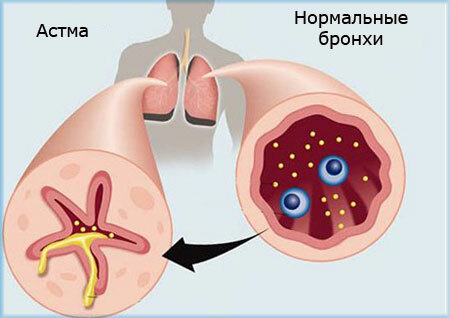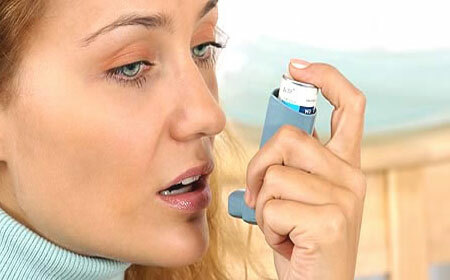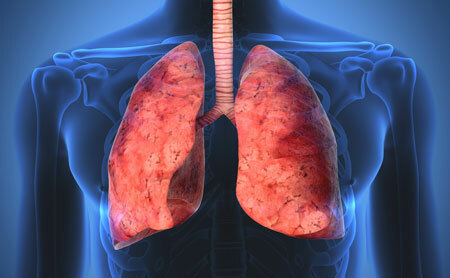Diseases of the respiratory tract and lung tissue that occur with inflammation and constriction of the bronchi are accompanied by asthma( asphyxiation).
Epithelium lining the bronchial tree is very sensitive to inhaled substances. They irritate the bronchi, causing hypersecretion and swelling, which prevents the entry of air into the lungs. Reflex bronchospasm additionally limits respiratory function.
Contents of
- 1 Asthma: What is it?
- 1.1 Types of asthma
- 2 Causes of asthma
- 3 Symptoms and signs of asthma, photos
- 4 First aid for asthma
- 5 Asthma treatment
- 6 Asthma: complications and prevention
- 7 Asthma code in ICD 10
Asthma: what is it?

Asthma is a disease of non-infectious bronchial structures, characterized by attacks of asphyxiation and bronchial obstructive syndrome. Diseases are characterized by a chronic course, with about a third of cases being hereditary.
If asthma is diagnosed in childhood - there is a chance of getting rid of it. In adults, the disease is much more complicated. The deterioration of the ecological situation leads to an increase in morbidity. The index among children reaches 10%, and in adults 6%.
Types of asthma
There are three main types of the disease, accompanied by an asthmatic condition. They are:
Bronchial asthma is a chronic lesion of bronchial mucosa with the development of hypersensitivity to inhaled( trigger) substances. It is manifested by periodic attacks of suffocation. Unlike bronchitis, infection plays a starting role, and the leading cause of the disease with bronchial asthma is a genetic predisposition.
- Symptoms and treatment of bronchial asthma
Drug asthma - occurs as a side effect on taking certain medications. There are two mechanisms - either the drug causes an allergy, which leads to the disease or the side effect of the medication causes spasm of bronchioles and an attack of suffocation.
Cardiac asthma - occurs as a result of pulmonary edema in heart failure. The mechanism is a decrease in the contractile function of the myocardium or a rise in pressure in the pulmonary system.
The most common cause of the disease is bronchial pathology.
Causes of asthma
The main causes of asthma are unknown, but it is believed that this combination of two factors: genetic and environmental influences. There are other risk factors that can trigger the onset of the disease. These include:
- Permanent contact with substances that cause allergic reactions - it's animal hair, dust, mold;
- Some medications( side effects of beta blockers that cause spasm of the bronchi);
- Respiratory and viral infections;
- Passive smoking;
- Ecological situation;
- Work in rooms with dirty air, with chemicals, flour;
- Products containing sulfates;
- Physical stress;
- Constant stress and nervousness;
- Sharp change in weather conditions;
- Hereditary factor.
Patients with allergic reactions need to address an allergist for establishing the exact causes.
Symptoms and signs of asthma, photos

Symptoms of asthma, photos
Since asthma is heart, bronchial or medicinal, the symptoms also differ. However, the first signs of asthma are the same - a strong dry cough and shortness of breath.
For allergic asthma , the symptoms are as follows:
- Cough appears;
- Whistling occurs during breathing;
- The person makes breaths and exhalations with a frequency of more than 16 / minute;
- In the chest area there are painful sensations;
- These signs are evident when a patient contacts an allergen.
For cardiac asthma , the following symptoms are typical:
- Coughing and choking occur at night in a dream;
- In the horizontal position, breathing becomes difficult, so the person assumes a semi-sitting position;
- There may be other signs that are characteristic of heart failure( swelling, shortness of breath);
- With physical exertion there is shortness of breath, the abdomen increases, the skin around the nose and lips takes a cyanotic shade.

Inhaler in case of an attack, photo 2
Symptoms of bronchial asthma are pronounced:
- Dry strong cough;
- Shortness of breath, which becomes stronger when an attack occurs;
- For attacks characterized by a strong cough and shortness of breath, after which abundant sputum is released;
- Depression and heaviness in the thorax;
- Attacks end abruptly, as they begin;
- At night, exacerbations occur due to shortness of breath in the horizontal position. As a result, the patient can suffocate all night from coughing;
- During the breathing, characteristic whistles are heard.
If you notice any symptoms, you should always contact a specialist for a correct diagnosis and, if necessary, begin treatment.
First aid for asthma
Asthmatic attacks are the main symptom of this disease. And relatives of a person with a disease should know what to do to stop an attack of bronchial asthma. This condition is diagnosed in the patient according to the following manifestations:
Symptoms of an attack of bronchial asthma
- A person assumes a position where the musculature is included in the respiratory process. To do this, he puts his feet on the width of his shoulders, and his hands rest on the edge of the bed or chair.
- Breath - quick, and the exhalation is long and painful, accompanied by a cough.
- During exhalation a strong whistle is heard.
- The skin takes a cyanotic shade and becomes cool.
- Cough is severe and severe.
What to do if you have asthma attacks? - The algorithm is as follows:
- Provide the patient with fresh air. It is better that he took the position sitting, it will facilitate the departure of phlegm during a cough.
- It is necessary to unbutton clothes so that there is no pressure on the chest.
- The patient needs to be given an inhaler.
- It is necessary to remove allergens, which can provoke an increase in the attack.
- The patient needs to drink a sedative( karapolol, valerian).It is necessary to take bronhorasshiruyuschie aerosol drugs, which are in the first-aid kit of asthmatics.
- If the situation is severe, then it is worth calling an ambulance. At the average condition it is possible to address to the attending physician.
- In the absence of improvements, physicians resort to infusion of steroid drugs.
- Rules for the care of an asthma attack must be known to the relatives and close people of the patient in order to help at the right time.
Treatment of asthma
Unfortunately, it is currently impossible to cure this disease. Throughout life, a person with this diagnosis must comply with and fulfill the prescription of doctors.

Treatment of asthma in adults includes the removal of seizures and the prevention of their occurrence again.
For this you use:
- Drugs of anti-inflammatory, antihistaminic nature.
- Bronchodilators that extend the bronchi to improve air patency. All medicines must be prescribed by a doctor.
- Breathing exercises are also necessary, it helps to remove acute inflammation of the bronchi.
- For the treatment of asthma use and folk remedies. However, before this, it is worth consulting with your doctor.
To improve the condition in the heart form, correction of cardiac diseases is necessary. Asthma is a chronic pathology, therefore therapy lasts a lifetime. With the observance of medical recommendations, the quality of life suffers insignificantly.
Asthma: complications and prevention of
If asthma is not treated, complications occur, namely:
- Pulmonary diseases: pneumonia, respiratory failure, pneumosclerosis, emphysema, chronic obstructive bronchitis.
- Cardiac pathology - hypotension, heart attacks, heart failure, arrhythmia.
- The gastrointestinal tract may suffer from taking medications necessary for therapy.
- Fainting, nervous disorders, asthenia, emotional instability are possible.
To prevent the disease from progressing, the following rules must be observed:
- To quit smoking;
- How often can cleaning in living quarters;
- Try to be fewer in places with polluted air;
- Limit contact with substances that cause allergic reactions;
- In time to treat respiratory diseases;
- Discard products with chemical composition;
- Pets must be clean. If the diagnosis is already made, then it is better not to start them;
- Drugs should be taken only as prescribed by physicians.
Treatment of patients with bronchial asthma is considered compulsory. This is a difficult process, dragging on for life. However, with all the appointments of doctors, the outlook is favorable.
Asthma code in ICD 10
In the international classification of diseases of ICD 10 asthma is:
Class X. Respiratory diseases( J00-J99)
J40-J47 - Chronic lower respiratory illnesses
J45 - Asthma
- J45.0 Asthma with predominance of allergiccomponent
- J45.1 Non-allergic asthma
- J45.8 Mixed asthma
- J45.9 Asthma, unspecified
Optional:
J46 - Asthmatic status



